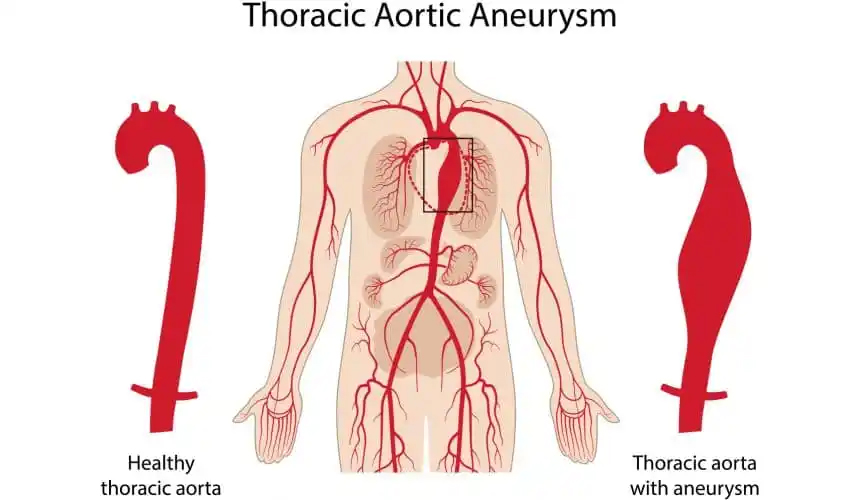
Thoracic Aortic Aneurysm (TAA) is a bulge in the Aorta, the largest vessel carrying blood to the rest of the body. They are relatively rare, occurring in 10 / 100, 000 people with around 20% of cases linked to family history of aneurysmal disease. The definite causes of the disease is still unknown, but some genetic connective tissue diseases and family history are highly linked. Other associated factors include smoking, hypertension and male sex.
The disease process is typically slow and the aneurysm grows over a long period of time. Hence, most patients with TAA are Asymptomatic. Others may feel some of the pressure effects of the bulge on nearby organs or structures. Some people complain of hoarseness or difficulty swallowing. Others may have chest pains. In acute disruption or dissection, patients typically complain of severe sharp pain.
Aortic dissection and rupture are major complications of TAA disease and could be fatal. These conditions lead to bleeding into heart sac or within the walls of the aorta itself and hence causing decreased blood flow other organs like brain, kidneys or legs. Depending on extent of malperfusion and condition of patient, deficits occur.
CTA scan of chest is the best modality to diagnose and monitor TAA’s. Chest X-ray may show it. MRI of chest also is an excellent diagnostic modality.
There are multiple treatment options available for patients with TAA. The disease process need to be thoroughly investigated along with the patients overall condition to come up with the best treatment approach for the patient. The size and location of aneurysm as well as type of aortic lesion among other factors make a difference on optimal treatment options in that particular situation.Treatment options include: medical management, Endovascular repair and open surgical procedures.
Staying healthy is beneficial for patients with aortic aneurysms. Although no specific lifestyle change can prevent aneurysms from developing, maintaining good blood pressure and avoiding smoking may slow their progression.
Medical management and monitoring is typically used for smaller TAA’s and High risk patients. Open surgery is usually offered in emergency acute ascending aortic dissections. Minimally invasive Endovascular repair has been successful in treatment of many advanced conditions with decreased complication rates.
Endovascular treatment is a procedure in which a Stent is placed inside the aortic vessel leading to redirection of blood into the tube graft instead of the diseased aorta. It is done through small access point into the vessels typically from the groin area. The recovery is fairly Quick and most patients go home within few days. Routine activities to be resumed gradually (Dr. Tamim) .
Follow up testing though is done routinely. Maintaining healthy lifestyle habits and medical optimization are also encouraged to slow down the progression of disease in the untreated segments of the aorta.
If you have a Thoracic Aortic Aneurysm, please give us a Call. Our American Board certified Surgeons can guide you on getting the latest minimally invasive treatment options if at all needed We are Here to Help!
MyUSADr. was created to assist you in making Critical Health Decisions. Our US based practicing Specialists provide Online Second Medical Opinion and Virtual Doctor visits to patients from all over the Globe. Feel free to reach out at any time..
Wael Tamim, MD, FACS
+19546108585
Fort Lauderdale, Florida

